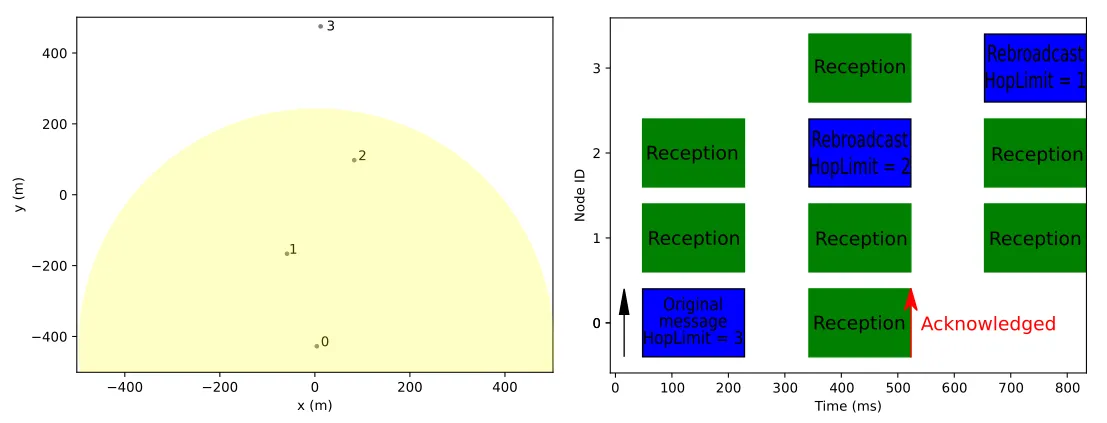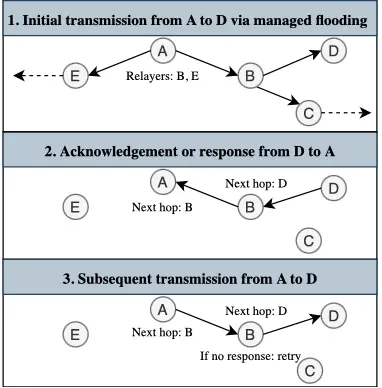Mesh Broadcast Algorithm
Current Algorithm
The routing protocol for Meshtastic is designed to support all kinds of different use-cases. Most importantly, it does not assume merely static nodes. If you want to test its theoretical performance, you can have a look at the simulator. The protocol is heavily influenced by the mesh routing algorithm used in RadioHead (which was used in very early versions of this project). It has four conceptual layers and (since version 2.6) uses a different approach for broadcasts and direct messages.
A Note About Protocol Buffers
Because we want our devices to work across various vendors and implementations, we use Protocol Buffers pervasively. For purposes of this document you mostly only need to consider the MeshPacket and Sub-packet message types.
Layer 0: LoRa Radio
All data is converted into LoRa symbols which are sent to the radio for transmission. The details are described elsewhere, but it is worth noting that in addition to the converted packet bytes described below, there is also a preamble sent at the start of any data packet.
This preamble allows receiving radios to synchronize clocks and start framing. We use a preamble length of 16, which is longer than the minimum preamble length of 8, to let SX126x LoRa receivers sleep for a while, which lowers power consumption.
After the preamble comes the LoRa Physical Header, which contains information about the packet length as well as a sync word to distinguish networks. For Meshtastic, it is set to 0x2B.
Layer 1: Unreliable Zero Hop Messaging
This layer is conventional non-reliable LoRa packet transmission. A packet generated by a Meshtastic device has the following representation before encoding for transmission:
| Offset | Length | Type | Usage |
|---|---|---|---|
| 0x00 | 4 bytes | Integer | Packet Header: Destination. The destination's unique NodeID. 0xFFFFFFFF for broadcast. Little Endian. |
| 0x04 | 4 bytes | Integer | Packet Header: Sender. The sender's unique NodeID. Little Endian. |
| 0x08 | 4 bytes | Integer | Packet Header: The sending node's unique packet ID for this packet. Little Endian. |
| 0x0C | 1 byte | Bits | Packet Header: Flags. See the header flags for usage. |
| 0x0D | 1 byte | Bits | Packet Header: Channel hash. Used as hint for decryption for the receiver. |
| 0x0E | 1 byte | Bytes | Packet Header: Next-hop used for relaying. |
| 0x0F | 1 byte | Bytes | Packet Header: Relay node of the current transmission. |
| 0x10 | Max. 237 bytes (excl. protobuf overhead) | Bytes | Actual packet data. Unused bytes are not transmitted. |
Packet Header Flags
| Index | # of Bits | Usage |
|---|---|---|
| 0 | 3 | HopLimit (see note in Layer 3) |
| 3 | 1 | WantAck |
| 4 | 1 | ViaMQTT (packet came via MQTT) |
| 5 | 3 | HopStart (original HopLimit) |
Usage Details
-
Packet Header: is described directly by the
PacketHeaderclass in the C++ source code. But indirectly it matches the first portion of theMeshPacketprotobuf definition. Note that the packet header is not encoded using a protobuf, but is sent as raw bytes. This both saves airtime and allows receiving radio hardware to optionally filter packets before waking the main CPU. -
Packet Header - NodeIDs: are constructed from the bottom four bytes of the MAC address of the Bluetooth address. Because the OUI is assigned by the IEEE, and we currently only support a few CPU manufacturers, the upper byte is de-facto guaranteed unique for each vendor. The bottom 3 bytes are guaranteed unique by that vendor.
-
Packet Header - Unique ID: The ID is a large, 32 bit ID to ensure there is enough unique state to protect an encrypted payload from attack.
-
Payload: An encrypted and packed protobuf encoding of the SubPacket protobuf. Only the SubPacket is encrypted, while headers are not. This allows the option of eventually allowing nodes to route packets without knowing anything about the encrypted payload. For more information, see the encryption and Protobuf API Reference. Any data past the maximum length is truncated.
Carrier-Sense Multiple Access with Collision Avoidance (CSMA/CA)
Meshtastic adopts CSMA/CA, similar as to what is used in WiFi. This means that all transmitters must perform Channel Activity Detection (CAD) before attempting to transmit. If the channel is considered busy, the node will wait until it is not anymore. Since once the channel becomes idle multiple nodes might want to start transmitting, a node has to wait a random multiple of slot times. The slot time is the time needed to reliably perform CAD. The amount of slot times to wait is randomly picked from a contention window (CW), which size depends on the current channel utilization. The contention window is larger for a higher channel utilization, in order to limit the chance of collisions.
Layer 2: Reliable Zero Hop Messaging
This layer adds reliable messaging between the node and its immediate neighbors only.
The default messaging provided by Layer 1 is extended by setting the WantAck flag in the MeshPacket protobuf. If WantAck is set, the following documentation from mesh.proto applies:
This packet is being sent as a reliable message, we would prefer it to arrive at the destination. We would like to receive an ACK packet in response.
Broadcast messages treat this flag specially: Since ACKs for broadcasts would rapidly flood the channel, the normal ACK behavior is suppressed. Instead, the original sender listens to see if at least one node is rebroadcasting this packet (because naive flooding algorithm). If it hears that, the odds (given typical LoRa topology) are very high that every node should eventually receive the message. So FloodingRouter.cpp generates an implicit ACK which is delivered to the original sender. If after some time we don't hear anyone rebroadcast our packet, we will timeout and re-transmit, using the regular resend logic.
If a transmitting node does not receive an ACK (or NAK) packet after a certain expiration time, it will use Layer 1 to attempt a re-transmission of the sent packet. A reliable packet (at this 'zero hop' level) will be resent a maximum of three times. If no ACK or NAK has been received by then the local node will internally generate a NAK (either for local consumption or use by higher layers of the protocol). The re-transmission expiration time is based on the maximum time it would take to receive an (implicit) ACK, taking the airtime of the sent packet and any processing delay into account. For direct messages, the intended recipient will also send a real ACK all the way back to the original sender, but the device will only retransmit when it received no ACK at all.
Layer 3: Multi-Hop Messaging
Broadcasts using Managed Flooding
Given the various use-cases and scenarios Meshtastic supports, most of our protocol is built around flooding, meaning that every node rebroadcasts a packet it receives, up till a certain hop limit. However, an important difference in Meshtastic is that before rebroadcasting, a node listens a short while to see if another node has already rebroadcasted the packet. If so, it will not rebroadcast. "Managed Flooding" is therefore a better term.
The principle is as follows. If any mesh node sees a packet with a HopLimit other than zero, it will decrement that HopLimit and attempt to rebroadcast on behalf of the original sending node. In order to promote letting nodes that are further away flood the message, such that the message eventually reaches farther, the contention window (see Layer 1) for a flooding message depends on the Signal-to-Noise Ratio (SNR) of the received packet. The CW size is small for a low SNR, such that nodes that are further away are more likely to flood first and closer nodes that hear this will refrain from flooding. An exception to this rule is for the ROUTER and REPEATER roles, that have a higher priority to rebroadcast and will do so even if they hear another node rebroadcasting.
Example
Below you see an example topology consisting of four nodes in CLIENT mode, where at a certain point node 0 wants to send a broadcast message.
Due to limited coverage, it only reaches nodes 1 and 2. Since node 2 is farther away, its SNR is lower and therefore starts rebroadcasting earlier than 1.
After node 0 received this rebroadcast, its message is acknowledged. Note that a message is already acknowledged once a rebroadcast from any Meshtastic node (whether or not it has the same encryption key) is received.
Since node 1 heard the rebroadcast by 2, it will not rebroadcast again. Node 3 heard the message for the first time and the HopLimit is not yet zero, so it starts a rebroadcast for potential other receivers.

Direct messages using Next-Hop routing
Since version 2.6, Meshtastic uses a different approach for direct messages. Initially, the managed flooding approach as mentioned before is used to reach the destination. We'll then keep track of the node(s) that are trying to relay the packet for us. If upon a successful delivery, a response comes back (e.g., a NodeInfo response, acknowledgment or traceroute) and the node that relays this towards you was also (one of) the node(s) that relayed the original packet, it will be denoted as next-hop from now on. This means that instead of letting all nodes try to relay the packet, only the node for which the next-hop byte matches will. Note that this is determined per hop, so if there is an asymmetric link or a node on older firmware in between, managed flooding will be used on this hop. When a node moves, or RF conditions change, it might be the next-hop is not valid anymore. Therefore, a node will always fall back to managed flooding at the last retransmission attempt if it doesn't hear its next-hop relay. The procedure is visualized in the following diagram:

Regular Broadcast Intervals
Without additional modules configured, nodes will produce three different types of regularly intervaled traffic as part of the mesh:
- Device Telemetry
- Controlled by
telemetry.device_update_interval - Default: 30 minutes
- Controlled by
- Position
- Controlled by
position.position_broadcast_secs - Default: 15 minutes* (with smart broadcast enabled)
- Controlled by
- NodeInfo user
- Controlled by
device.node_info_broadcast_secs - Default: 3 hours
- Controlled by
As meshes grow larger and traffic becomes more contentious, the firmware will increase these intervals. This is in addition to duty cycle, channel, and air-time utilization throttling.
Starting with version 2.4.0, the firmware will scale back Telemetry, Position, and other ancillary port traffic for meshes larger than 40 nodes (nodes seen in the past 2 hours) using the following algorithm:
ScaledInterval = Interval * (1.0 + ((NumberOfOnlineNodes - 40) * 0.075))
For example an active mesh of 62 nodes would scale back telemetry.device_update_interval to 79.5 minutes instead of the 30 minute default.